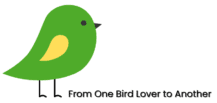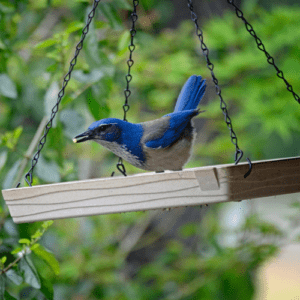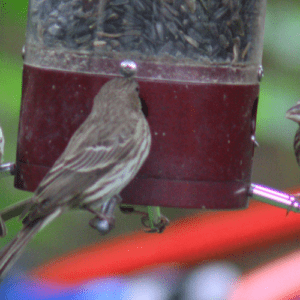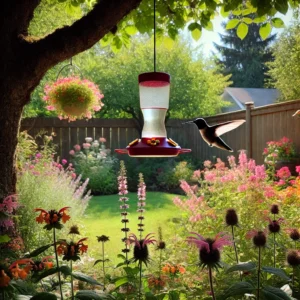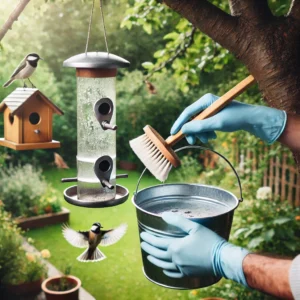If you had told me a few years ago that I would be spending my mornings sitting by the window, coffee in hand, watching my backyard come to life with birds of all kinds, I would have thought you were joking. But after many years of birding and placement trial and error, I’ve learned that where to place bird feeders is the key to transforming any yard into a thriving bird haven. Trust me, getting the right spots for your feeders is worth it!
I’ve been lucky enough to experience the joy of seeing finches, sparrows, and even a few unexpected guests like blue jays and woodpeckers visit my feeders, and let me tell you—it’s magical. So, whether you’re a newbie trying to get started or a seasoned birder looking to optimize your setup, I’m here to share what I’ve learned. Spoiler alert: placement matters.
Why Feeder Placement Matters
I remember setting up my first bird feeder, full of excitement but feeling a bit deflated after days of seeing nothing. I had made the classic mistake of thinking that simply hanging a feeder in the middle of the yard would automatically attract birds. But no—after days of zero activity, I learned quickly that placement is far more important than simply putting up a feeder.
Birds are creatures of habit, and they tend to stick to places where they feel safe, and comfortable, and where there’s access to food and shelter. Over the years, I’ve discovered that the best feeders aren’t just “set it and forget it.” They need to be in spots that cater to the birds’ natural behaviors, where they can feed without feeling exposed. Trust me, with a little thought and planning, you can easily create a backyard that the birds will love.
The Best Placement for Bird Feeders: Near Trees, Shrubs, and Natural Cover
One of the best lessons I’ve learned through trial and error is that cover is absolutely crucial for attracting birds. If you’re wondering where to place bird feeders to really draw in the feathered friends, the answer is close to trees, shrubs, or any kind of natural cover. Birds love a safe place to land and retreat, especially if they sense danger like a hawk or a predator.
I had a lightbulb moment when I finally moved my feeders closer to the edges of my yard, where the trees and bushes meet the open space. It was like flipping a switch—suddenly, the birds felt safe enough to visit. The bushes provide shelter, while the trees give them a perfect perch to wait their turn at the feeder. Now, every time I step outside, I hear the familiar chirps and flutters of birds feeding in the safety of these well-placed spots.
Pro Tip: trees with low-hanging branches or thick foliage are perfect for keeping your feeders sheltered from predators. Birds love these spots, and having somewhere to rest between snacks doesn’t hurt either!
Height Matters: How Far from the Ground Should You Hang Your Feeders?
Now, when I first started, I thought placing my feeders low to the ground was a good idea. But after a couple of weeks of waiting (and feeling a little defeated), I figured out that height is a game-changer. I raised my feeders to about 4-6 feet off the ground, and that’s when the magic started to happen.
Small birds like finches and sparrows seem to like feeders that are a little lower, but larger birds, such as cardinals and jays, prefer feeding from higher up. The best part? Placing feeders higher off the ground means they’re less likely to be raided by squirrels or other ground predators. I personally use sturdy poles with baffles (those cool squirrel barriers), and I’ve never looked back.
| Bird | Ideal Hight | Feeder Type | Tip |
| Finches (House, Gold, Purple) | 4-6 feet off the ground | Tube feeders, Sock feeders | Place near shrubs or trees for quick escape routes. |
| Cardinals | 5-10 feet off the ground | Platform feeders, Hopper feeders, Tube feeders | Ensure nearby dense shrubs or small trees for cover. |
| Chickadees | 5-7 feet off the ground | Tube feeders, Suet cages, Platform feeders | Add small trees or shrubs nearby for safety. |
| Woodpeckers | 6-10 feet off the ground | Suet feeders, Suet cages | Mount on tree trunks or sturdy poles for a natural feel. |
| Blue Jays | 6-8 feet off the ground | Platform feeders, Hopper feeders, Tube feeders | Place feeders near trees with open space for easy access. |
| Sparrows | 4-6 feet off the ground | Platform feeders, Tube feeders, Hopper feeders | Combine open space and shrubs to attract sparrows. |
| Hummingbirds | 3-5 feet off the ground | Hummingbird tube or bottle feeders | Position near flowering plants or shrubs for natural cover. |
Feeder Placement and Safety: Protecting Birds from Predators
Let’s face it: we all want to attract birds, but we also want to make sure they’re safe while they feed. I learned this lesson the hard way when I placed my first feeder in an open area without thinking about the predators lurking around. Birds are very cautious, and if they feel exposed, they will avoid the area.
For a long time, I had feeders in the middle of my yard, and, as you can imagine, that didn’t work well. Birds just didn’t feel safe there. I moved my feeders to spots where they were sheltered but still had a clear view of the yard. About 10 feet away from large trees or structures is the sweet spot, giving birds the time they need to fly to safety if a predator comes around.
Avoiding Windows: Don’t Let Birds Crash Into Them
I learned this one the hard way. You’d think windows would be a non-issue, but I quickly found out that bird strikes are a real danger. Birds often can’t see glass and will fly right into it, sometimes with devastating consequences. I once had a cardinal try to make a beeline for a feeder near a window, and he ended up crashing right into the glass.
Since then, I always keep feeders at least 3 feet away from any windows. I also added window decals and installed a screen to reduce the chance of accidents. It’s a small change, but it’s definitely made a difference in protecting the birds that visit.
The Importance of Proximity to Bird Baths
Here’s another tidbit from my backyard: birds also need water. I always thought it was just about food, but once I added a bird bath near my feeders, the bird traffic increased significantly. Birds love having easy access to both food and water, and I’ve noticed that placing the bird bath about 5-10 feet from the feeders has created a lovely feeding station where birds can fuel up and hydrate at the same time.
In winter, I even added a little solar-powered bubbler to keep the water moving and prevent it from freezing. The movement attracts even more birds, and now I’ve got a constant stream of feathered visitors year-round.
Where to Hang Suet Bird Feeders
If you’re wondering where to hang suet bird feeders, the answer is simple—on a tree trunk or sturdy branch. I place my suet feeders about 5-6 feet off the ground, which is where woodpeckers, chickadees, and nuthatches naturally forage for food. I’ve had the best luck when the suet feeder is attached to a tree trunk because it mimics their natural foraging environment.
If you don’t have trees, don’t worry—mount the suet feeder on a pole with a baffle to keep those pesky squirrels away. And just like with seed feeders, try to place your suet feeders away from areas with high foot traffic. Birds need peace and quiet while feeding, and these secluded spots work wonders.
Dealing with Squirrels: Feeder Placement Tips
Oh, squirrels. If you have them in your yard, you know the drill—they’ll find your feeders no matter what. But I’ve learned a few tricks over the years. Squirrels can jump up to 10 feet horizontally, so when placing your feeders, make sure they’re at least 10 feet away from trees, fences, or structures they can use to launch themselves at the feeders.
If squirrels are still giving you a hard time, invest in squirrel-proof feeders. The ones with weight-activated mechanisms work like a charm! Alternatively, a pole with a baffle will create a slick barrier that keeps the squirrels from climbing up. Trust me, with these adjustments, your feeders will be squirrel-free and ready for your feathered visitors.
Experiment and Observe: Watch for the Best Results
At the end of the day, the best way to learn where to place bird feeders is through good old-fashioned observation. Place your feeders where you think they might work, and then sit back and watch. Keep track of which birds show up and where they prefer to hang out. Over time, you’ll get a feel for their favorite spots and be able to fine-tune your setup for maximum results.
Unusual Tips and Tricks for Optimal Feeder Placement
Over the years, I’ve picked up a few tricks that have made a huge difference in attracting birds to my backyard. These aren’t your typical “put the feeder near a tree” tips—these are things I’ve learned from experimenting and observing:
Think about wind direction: Strong winds can make feeding difficult for birds. I’ve found that placing my feeders in a sheltered spot, like near a building or hedge, keeps the seeds in place and makes the birds feel more comfortable.
Try a variety of feeders: Birds are picky! So, I use tube feeders for finches, platform feeders for sparrows, and suet feeders for woodpeckers. Having a variety of feeders at different heights gives birds more options and attracts more species.
Add natural perches: I started putting up branches from my own backyard trees as perches near the feeders. The birds love having a place to rest while they wait their turn at the feeder.
Create a “bird buffet”: I stopped using just one type of seed mix and started placing different treats (sunflower seeds, dried fruit, mealworms) around my yard. The variety has really increased the traffic.
Rotate Feeder Locations: Moving the bird feeder to different spots in the yard every few weeks helps minimize the accumulation of waste and reduces the spread of diseases. Also, rotating the feeder prevents any predator, such as hawks, from creating patterns of hunting near the feeder area.
Final Thoughts: Creating a Bird-Friendly Space
Bird feeding isn’t just about filling up a feeder and hoping for the best. It’s about creating an environment that makes birds feel safe, comfortable, and welcome. From thoughtful placement near trees and shrubs to keeping your feeders away from windows and predators, I’ve learned that a little planning goes a long way in attracting more birds to your yard.
So go ahead—experiment, get creative, and watch your backyard come to life. It takes time and patience, but I promise it’s worth it when you see all those birds fluttering in. Happy bird watching!
